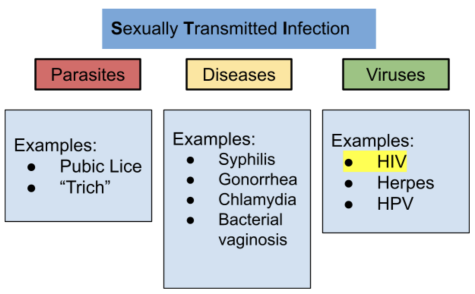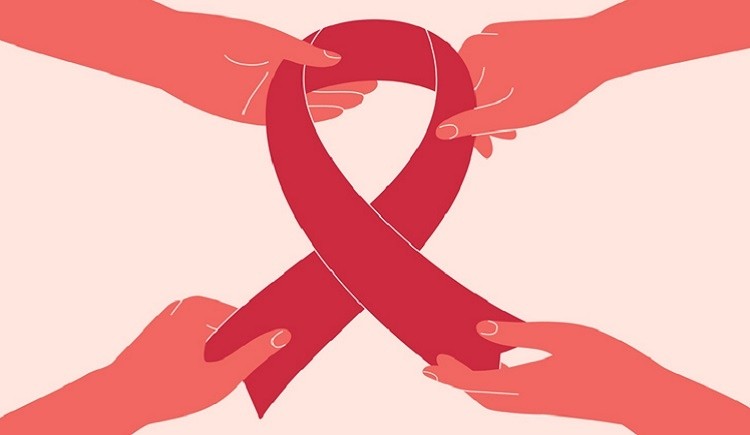What is HIV?
While some may think the the letters HIV stand for Hippos Intending Violence, it does not. It really means:
H-human
I- immunodeficiency
V- virus
Some things to get out of the way: HIV is not AIDS, and it is not an STD. It is a virus that attacks white blood cells. Once someone has HIV, it stays with them for the rest of their lives, but you shouldn’t be scared. According to U.S. Statistics, today in 2022 there Approximately 1.2 million people in the U.S. have HIV, and you can still live a completely normal life while being HIV positive. People who have HIV and have good treatment get to a point where the virus reaches levels so low it is undetectable.
How do you get it?
In most circumstances HIV is considered as an STI (sexually transmitted infection) which is different than and STD (sexually transmitted disease). There are really three variables that fall under the “jurisdiction” of STIs: parasites, diseases, and viruses. HIV is a Virus (seen below).

Each of these are treated differently; parasites and diseases each have easier one-time treatments (unless you get it again), but the viruses like HIV, Herpes, and HPV are with you for life. If someone has HIV or HPV, it needs to be continuously monitored and checked in on HIV more than HPV.
These viruses come from sharing sexual fluids, breast milk, or blood, like sharing needles, breastfeeding a baby while being HIV positive, or having non-barrier protected sex.
HIV History
When looking at most timelines, what is considered to be the first outbreak—the first official cases—is marked as 1981(Wikipedia), however it has been around for way more than only 41 years. Historians have actually traced what they think was the first ever case of HIV to the Democratic Republic of the Congo in 1959 after a “retrospective analysis of frozen blood samples from a variety of African countries” according to Timeline Avert.
According to the World Health Organization, “Since the beginning of the epidemic, 79.3 million people have been infected with the HIV virus and 36.3 million people have died of HIV” overall. These numbers look scary but it is important to keep in mind that in 2022 people will live just as full lives being HIV positive as those who are HIV negative.
So far the oldest known patient with HIV lived to the age of 100 in Lisbon, Portugal, after being diagnosed at age 84. The reality is that people can still live full and beautiful lives. Today there are some people born with HIV, as it can be passed during birth, but now there are treatments to protect babies that are at risk to get HIV.
What is PrEP?
PrEP stands for Pre-Exposure Prophylaxis, and is for peoplewho do not have HIV but are at a higher risk for exposure. PrEP is a treatment for people who do not have HIV. PrEP might be a good idea for someone with a HIV positive partner, or doesn’t practice safe sex with partners that could possibly have HIV. PrEP is also a good idea for people who may share needles. PrEP builds up your immune system so that if the HIV virus is introduced to your system it is ready to fight it off. PrEP was first approved by the US in 2012 and is still a relatively new drug.
It has been shown that PrEP works best when taken every day, almost like a birth control pill. PrEP is 90% effective in preventing HIV being sexually transmitted, the best combination is to use PrEP with condoms. PrEP is 70% effective when preventing the transmission of HIV through shared needle use. Planned Parenthood’s website or YouTube channel has great sources and videos that help explain PrEP what it does and how it works. You can also talk to your doctor about starting PrEP; some doctors offices have it (including Planned Parenthood).
What is PEP?
PEP stands for Post Exposure Prophylaxis was approved by the CDC in 2005, so it is a little bit on the newer side and can’t be found in many doctors’ offices. PEP is essentially (for lack of a better term) a ‘plan B’ for an HIV exposure. PEP is used when someone who does not have HIV or is not on PrEP is exposed. PEP should be used within 72 hours after someone has an exposure (the sooner the better) and should not be used on a regular basis. After the exposure, one must continue taking PEP every day for the next 28 days, and then get tests after 3 months.
Testing
According to the CDC, “There are three types of tests available: nucleic acid tests (NAT), antigen/antibody tests, and antibody tests. HIV tests are typically performed on blood or oral fluid. They may also be performed on urine.” HIV tests can be performed in and out of doctors offices, as there are some tests that can be mailed in or bought in stores. It is best to visit with your doctor to find the best way of testing for you.
“The CDC recommends that everyone between the ages of 13 and 64 years old be screened for HIV at least once as part of their routine health care. More frequent testing is recommended for people who have a higher risk of infection because of behaviors such as having sex without condoms, having sex with multiple partners, or injecting drugs using shared needles.”
Where can someone get treatment?
According to Planned Parenthood:
“It’s important to find a doctor who has experience treating HIV. Your local Planned Parenthood health center can help you get the treatment you need. HIV.gov can also help you find an HIV doctor and other support services in your area.
Antiretroviral therapy (ART) is a combination of medicines that slows down the effects of HIV in your body and can help you stay healthy for many years. It can also lower or even stop your chances of giving HIV to anyone else. ART lowers the amount of HIV in your body (called your viral load) — sometimes to the point where HIV won’t show up on standard blood tests. If your HIV viral load is so low that certain tests can’t see it, it’s called “undetectable.” When someone has an undetectable viral load, they can’t spread HIV to others during sex.
It’s important to remember that even with an undetectable viral load, HIV is still present in your body. If you stop treatment your viral load can go up, making it possible to pass HIV to others you have sex with. Your doctor or nurse can help you find the treatment that’s best for you to help keep your viral load low, so you can stay healthy.”
How is someone supposed to pay for treatment?
Most health insurance covers all or most of the cost of HIV treatments. If someone is under a plan that doesn’t cover it, or doesn’t have a plan at all, there are Federal Resources that can help. Toll-free State HIV/AIDS Hotlines “will help put you in touch with agencies that can determine what programs and services you may be eligible for and help you access them(HIV.gov)”.
These are all organizations that can help people find the money to get properly treated for HIV:
- The Ryan White HIV/AIDS Program
- Medicaid
- The Health Center Program
- Medicare
If you stuck around, I thank you for doing your part to learn about this virus that impacts so many people around the world today. By educating ourselves about the things we don’t know, we help decrease the fear and shame that people often associate as part of HIV. Thank you for contributing to this large community of strong individuals working hard everyday to defeat the HIV Stigma. |
Questions:
Earlier in the week students were randomly asked to take a survey to see what they knew about HIV: These were some their answers:
| Questions from students | Answers |
| 1.How long does it take to get tested? | Depending on what kind of test you get it could take anywhere from 1-30 minutes in an office or a few days if a blood test is sent to a lab |
| 2. How to prevent it? | You can only really prevent it by practicing safe sex with barrier methods, making sure you and your partner have been tested, or being on the PrEP pill. |
| 3. Can it be cured or just treated? | It can only be treated |
| 4.How did Magic Johnson and eazy-e get it? | Most likely from being exposed through needle sharing or unsafe sex |
| 5.How does it affect someone’s daily life? | As long as the person is being treated they can live full and happy lives just like everyone else |
| 6.Specifically the difference. And like, the detailed process of how it infects you. (I DON’T NEED TO KNOW THE PROCESS OF GETTING IT) | It is a complicated virus, (without going into too much detail) it basically attacks your white blood cells which is what allows your body to fight off other diseases. Before there was proper treatment people would get sick with something like pneumonia and their health would get worse and worse because their white blood cell count was so low |
| 7. Are doctors working on a cure? | There are doctors and scientists still working on finding a cure for HIV but haven’t found one yet. |
| 8. More about how it can affect everyone around the person ig idrk | Someone who is HIV positive has no impact on the people around them. The problem lies in the stigma around HIV and the fear of being open about one’s self to the people around them. |
